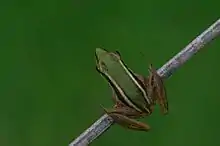Hylarana tytleri
Hylarana tytleri is a frog species in the family Ranidae. It is found in eastern and northeastern India, Bangladesh, and southern Nepal, and possibly at lower elevations in Bhutan.[1][2] It was formerly placed in Rana, and included in the common green frog (H. erythraea). It is probably a close relative of that species nonetheless, and thus placed in the revalidated genus Hylarana, of which H. erythraea is the type species.[3] Common name Theobald's ranid frog has been coined for it, although common names for Indian frogs previously identified as Rana erythraea include yellow-striped frog, leaf frog, and leaping frog.[2]

| Hylarana tytleri | |
|---|---|
 | |
| Scientific classification | |
| Domain: | Eukaryota |
| Kingdom: | Animalia |
| Phylum: | Chordata |
| Class: | Amphibia |
| Order: | Anura |
| Family: | Ranidae |
| Genus: | Hylarana |
| Species: | H. tytleri |
| Binomial name | |
| Hylarana tytleri Theobald, 1868 | |
| Synonyms[2] | |
|
Hylorana tytleri Theobald, 1868 | |
Description
Males grow to a maximum size of 33 mm (1.3 in) and females to 45 mm (1.8 in) in snout–vent length (SVL). The head is moderately elongated. The shanks are relatively long (about 55% of SVL). Webbing is partial. The body is uniformly greenish with two whitish or yellow lines laterally on back. There are two distinct brown lines on inner side of latero-dorsal folds. No mid-dorsal line is present.[4]
Habitat and conservation
Hylarana tytleri is a lowland (below 300 m (980 ft) above sea level) species associated with a variety of aquatic habitats including pools, lakes, marshes, and artificially flooded agricultural areas. It may venture into bank side vegetation and into scrubland and tropical forest habitats. It is a common species, but water pollution with agrochemicals can be a threat. It may also suffer locally from over-collection for food. It is not considered a threatened species by the IUCN.[1]
References
- Sushil Dutta, Sabitry Bordoloi, Annemarie Ohler, Saibal Sengupta, Mohini Mohan Borah (2004). "Hylarana tytleri". IUCN Red List of Threatened Species. 2004: e.T58742A11835603. doi:10.2305/IUCN.UK.2004.RLTS.T58742A11835603.en. Retrieved 17 November 2021.
{{cite journal}}: CS1 maint: multiple names: authors list (link) - Frost, Darrel R. (2017). "Hylarana tytleri Theobald, 1868". Amphibian Species of the World: an Online Reference. Version 6.0. American Museum of Natural History. Retrieved 16 September 2017.
- Stuart, Bryan L. (2008). "The phylogenetic problem of Huia (Amphibia: Ranidae)" (PDF). Molecular Phylogenetics and Evolution. 46 (1): 49–60. doi:10.1016/j.ympev.2007.09.016. PMID 18042407. Archived from the original (PDF) on 2016-03-03. Retrieved 2011-08-30.
- Ohler, A. & Mallick, P. K. (2002). "Rana (Hylarana) sensu Dubois (1992) in India and the identity of Hylorana tytleri Theobald, 1868". Hamadryad. 27: 62–70.
